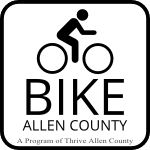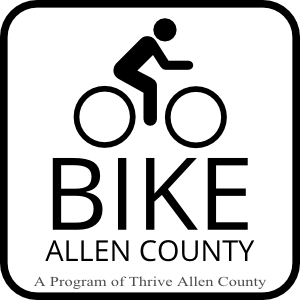Kansas Bicycling Laws
 Bicyclists have the same rules, rights and responsibilities as other drivers. For example, bicyclists must stop at stop signs and drive on the right-hand side of the road.
Bicyclists have the same rules, rights and responsibilities as other drivers. For example, bicyclists must stop at stop signs and drive on the right-hand side of the road.- The law does not require a helmet.
- Kansas law requires that vehicles pass bicycles with at least three (3) feet of clearance.
- Bicycles and motorized bicycles may ride on any street except travel lanes or shoulders of interstate highways, or where prevented by a local law.
- Anyone riding between sunset and sunrise must have a headlight on the front of the bicycle and a red reflector on the rear of the bicycle.
- All bikes must have brakes that work.
 Bicycles may be ridden on sidewalks except where prevented by local law. Pedestrians have the right of way and bicyclists must alert walkers by voice, horn or bell.
Bicycles may be ridden on sidewalks except where prevented by local law. Pedestrians have the right of way and bicyclists must alert walkers by voice, horn or bell.- Generally, bicyclists may not ride more than two abreast.
- Use hand signals to alert other roadway users to your intentions — left arm out and turned down to indicate a stop, left arm pointing left to indicate a left turn, left arm out and up (or right arm pointing right) to indicate a right turn.
- When stopped at a traffic signal that does not detect your presence in a reasonable amount of time, you may, when it is safe to do so, bypass the defective traffic signal.
- Bicyclists are not required to use sidewalks, trails, multi-use bike paths, bike lanes, or shoulders, other than “a usable path for bicycles adjacent to a roadway” dedicated solely to bicycle traffic.
 Motorists may not do anything, even something that otherwise appears to be legal, that endangers a bicyclist, pedestrian, or other motorist. Safety, not speed, is the highest consideration in traffic law.
Motorists may not do anything, even something that otherwise appears to be legal, that endangers a bicyclist, pedestrian, or other motorist. Safety, not speed, is the highest consideration in traffic law.- This means that motorists must treat bicycles as any other vehicle. For instance, do not pull out in front of a moving bicyclist, cut a bicyclist off, or pass a bicyclist unsafely.
- When traveling slower than traffic, bicyclists generally move to the right of the travel lanes, just as other slow moving vehicles do. But do not expect bicyclists to hug the curb, dodge in and out between parked cars, or ride on a debris-covered shoulder. Bicycling that way is not safe, and the law requires bicyclists to ride safely.
- If the lane is too narrow to safely share between a bicycle and a motor vehicle, the bicycle may move towards the center of the lane so as to discourage motor vehicles from dangerously squeezing past in the lane. If you see a bicyclist riding in the middle of the lane in this way, the bicyclist is following the law. Slow and wait behind the bicyclist until it is safe to move into the next lane to pass.
- Bicyclists may sometimes ride the shoulder of the road when available. But they are not required by law to do so.
- Bicycle lanes may not be blocked or used for parking. Motorists must signal and yield to any bicyclists in the lane before crossing a bicycle lane. As with shoulders, bicyclists may leave the bike lane for any number of reasons, including debris, obstacles, or to prepare for a turn.
Note: This is abridged/summarized version (adapted from pophamlaw.com) of state law. For a complete listing, see Kansas Bicycle Laws and Statutes from Kansas Cyclist, or Bicycling Statutes from KDOT.
Allen County Bicycling Laws
The bicycling laws in Allen County are largely the same as they are statewide (since local law cannot contradict state law). However, there are a few specific ordinances to note:
Iola
- Any resident of the City of Iola can register their bicycle with the Iola Police Department during normal business hours. Registration is not required but is highly recommended. There are no fees for bicycle registration. 90-142
- A person operating a bicycle upon and along a sidewalk, or across a roadway upon and along a crosswalk, shall yield the right-of-way to any pedestrian and shall give an audible signal before overtaking and passing such pedestrian. A person operating a vehicle by human power upon and along a sidewalk or across a roadway upon and along a crosswalk shall have all the rights and duties applicable to a pedestrian under the same circumstances. Bicycles may be ridden upon sidewalks in the central business district. Riders should exercise special caution to prevent conflicts, avoid areas close to store entrances, yield to pedestrians, and walk bicycles in congested areas. 90-143
- It is unlawful for any person to park or leave a bicycle on public property where such bicycle blocks pedestrian travel or presents a traffic hazard. 90-144
We are not aware of any bicycle-specific ordinances in any other Allen County municipality.
Kansas Bicycle Safety Tips and Statutes
The following illustration (from the Kansas Bicycle Map), provides a good overview of safety tips and statutes for people who ride bicycles:

Bicycling With Sharrows
Both Humboldt and Iola use sharrows on city streets. These simple street markers serve several purposes. They remind people in cars to expect bicycle traffic. They remind people on bikes to ride with the flow of traffic, and to ride where they are visible and away from parked vehicles or other hazards.

This cartoon (from BikeyFace) illustrates how to ride with sharrows. In general:
- Share a lane side-by-side with cars only if the lane is at least 14 feet wide
- Stay out of the gutter! On narrow lanes (less than 14′) ride in 2-3 feet from the gutter
- On streets with “shared lane arrows” or “sharrows,” ride dead center over the sharrow
- Ride six feet from parked cars to avoid the door zone
- Be predictable — ride a straight line.
The cartoon also illustrates what not to do — don’t be a gutter bunny! Riding too close to the edge of the roadway is unsafe, and should be avoided, as it invites motorists to pass too closely, even when there’s not enough room to do so.

